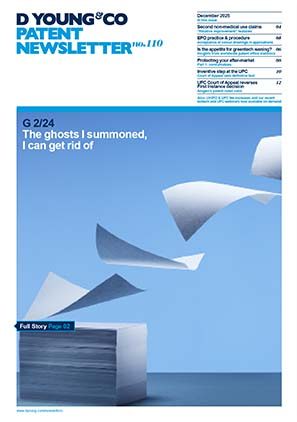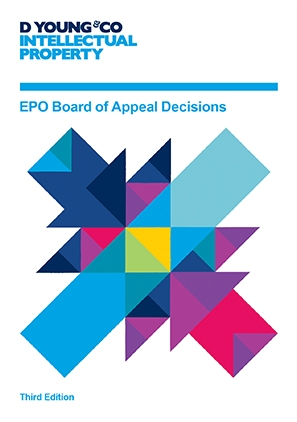EPO sufficiency: can medical use claims encompass all patients if the majority are non-responders?
If a therapeutic benefit is only observed in a sub-group of patients (in particular, a small group), is a claim sufficient if it claims all patients or do the non-responders need to be disclaimed? This was the question posed in T0421/14, an appeal decision concerning the opposition division’s decision to maintain patent EP1732548 in an amended form.
According to established case law of the Boards of Appeal, in order to meet with the requirements of sufficiency under Article 83 EPC ("The European patent application shall disclose the invention in a manner sufficiently clear and complete for it to be carried out by a person skilled in the art”) the therapeutic efficacy of the composition and the dosage regime for the claims therapeutic indication must be at least credible/plausible from the description and/or common general knowledge.
In T0421/14 (Acorda Therapeutics Inc v Synthon BV neuraxpharm Arzneimittel GmbH) a key objection asserted against the patent was that the desired therapeutic benefit was only attained in a small subpopulation of “responders” rather than in all patients and, thus, the claims were not sufficient.
The medical use claims at issue in this case concerned the use of a sustained release composition at a specific dose in a specific dosage regime for increasing the walking speed of a patient with multiple sclerosis.
The patent contained data from a clinical trial but no statistically significant difference was found in the trial. However a post-hoc analysis of the data (which was included in the patent) using revised clinical benefit criteria showed that a statistically significant therapeutic benefit was attained; however this benefit was observed in only in a small sub-population of patients.
The appellant-opponents argued that the claims lack sufficiency because the therapeutic effect was only obtained in a small sub-population of patients.
A secondary issue in this case was whether copies of a poster and slides filed by the patentee in an information disclosure statement on the sister US case were citeable as prior art; in the information disclosure statement the patentee stated these materials had been presented at a public conference. In this appeal the respondent-proprietor argued that there was reasonable doubt that the poster and slides filed in the information disclosure statement were identical to what was presented.
Findings of the Board of Appeal
The Board of Appeal noted that patients with multiple sclerosis experience variability in the occurrence of their symptoms and, because of this, it can be difficult to recognise the clinical benefits of therapies. In this case, only about one third of patients were found to be responders under the revised post-hoc criteria.
The Board of Appeal confirmed that the existence of non-responders is not a reason to deny sufficiency of the disclosure. Additionally, they confirmed that non-responders do not need to excluded or disclaimed.
The Board of Appeal highlighted that the existence of a substantial proportion of non-responders is a common phenomenon which is observed with drugs in many treatment areas such as diabetes, migraine and cancer treatment. Additionally they pointed out that it is common practice to treat patients with a drug and change their medication should it turn out that they do not respond to treatment.
Further, the Board of Appeal confirmed that the requirements of Article 83 EPC are met if it can be shown that a relevant proportion of patients benefit from a treatment and that it has acceptable safety because the skilled person has the necessary technical information to perform the treatment. In this case the Board of Appeal found that the alleged therapeutic efficacy and safety was credible/plausible on the effective date of the patent (that is, claims met with the requirements of sufficiency) when restricted to the specific compound used in the examples.
In connection to the poster, the Board of Appeal held that because this evidence was within the power and knowledge of the respondent-proprietor that its admissibility as prior art should be assessed against the standard criteria of “overall balance of probability”. The Board of Appeal held that there was little doubt that the poster (even if it had typographical errors) was displayed at the conference. If evidence from witnesses (such as the presenters) had been provided that the poster had not been displayed then the Board of Appeal may have been persuaded otherwise.
In contrast, the Board of Appeal held the slides were not prior art. They noted that slides are typically used as the basis of an oral presentation and that the printed content of slides alone is insufficient for establishing precisely what members of an audience would have understood and retained. The absence of evidence as to what was shown to the audience (such as a handout of the slides presented at the conference) was a persuasive factor in the decision the board reached.
Practical points
The existence of non-responders in data is not, on its own, a reason to deny sufficiency under European patent practice. Moreover, there is no need to disclaim non-responders from medical use claims even if the majority of patients are non-responders. However you do need data to show that the responders do benefit from the therapy and there is acceptable safety (in other words, the therapeutic efficacy is credible/plausible); ideally this data is in the specification. As always, scientists should keep accurate records of what they actually present at public events such as conferences.
T 0421/14
View T 0421/14EP1732548
View EP1732548

